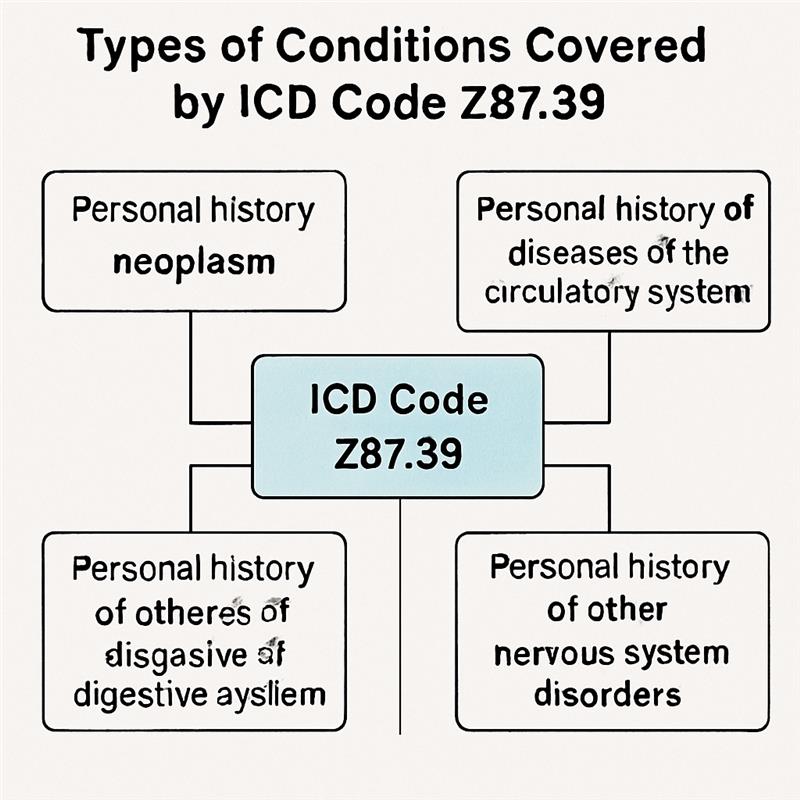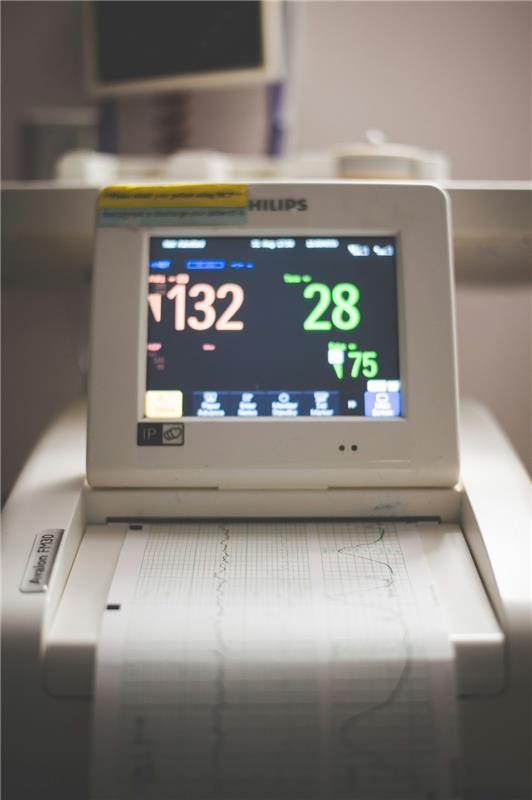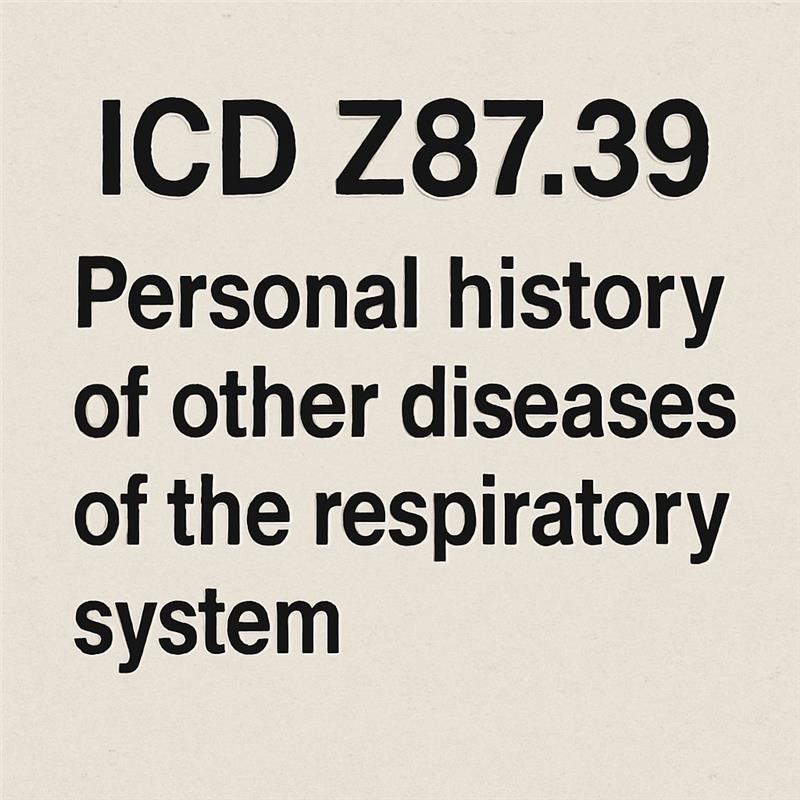Navigating the world of medical coding can be complex. ICD Code Z87.39 is a key part of this system. It plays a crucial role in documenting patient histories.
This code is part of the ICD-10-CM system. It helps healthcare professionals record past conditions that may impact future care. Understanding its use is vital for accurate medical documentation.
ICD Code Z87.39 is not for current conditions. Instead, it highlights resolved issues that still matter. This ensures comprehensive patient records.
Medical coders and healthcare providers must know when to use this code. Proper use can improve patient care and prevent claim denials.
Stay informed about ICD Code Z87.39. It’s essential for effective healthcare management.
What Is ICD Code Z87.39?
ICD Code Z87.39 falls under the ICD-10-CM coding system. This code helps categorize patients’ medical histories for healthcare providers. Understanding its role is crucial for accurate documentation.
This code is listed in Chapter 21 of the ICD-10-CM. The chapter focuses on factors influencing health status. It also includes contact with health services, making Z87.39 vital for comprehensive patient records.
Z87.39 specifically addresses the “Personal history of other diseases of the musculoskeletal system and connective tissue.” It records past medical issues that could affect current or future treatments. This is essential for crafting a complete patient health profile.
Z87.39 is non-billable on its own. Additional specificity is needed for billing purposes. Coders must use this code alongside other relevant codes to ensure completeness. This paints a full picture of the patient’s health history.
Understanding the context in which Z87.39 is used can be confusing at times. Here’s a summary of the key points:
- Non-billable without additional codes.
- Used for past conditions that may impact future health.
- Requires accurate documentation to prevent issues in billing.
Medical professionals must recognize the importance of using Z87.39 effectively. It contributes to better healthcare outcomes by providing a complete picture of the patient’s health journey.
The Role of Z87.39 in Medical Coding
ICD Code Z87.39 plays a crucial role in medical coding. It assists healthcare providers by documenting resolved medical conditions. These conditions may still have long-term effects on the patient.
The code is instrumental in outpatient settings. Clinics and physician offices often use it to track patient histories. This allows healthcare workers to ensure continuity of care.
Using Z87.39 with other ICD codes provides a complete view of a patient’s medical history. This can greatly aid in preventative care planning. It helps clinicians anticipate health issues based on past medical histories.
Here’s how Z87.39 contributes to medical coding:
- Ensures accurate documentation of patient histories.
- Offers insights into previous treatments affecting future care.
- Supports healthcare analytics by tracking resolved conditions.
Medical coders must ensure the proper use of Z87.39 to avoid billing errors. The guidelines for using this code emphasize accuracy and relevance. Accurate coding improves patient care and facilitates healthcare decision-making. By understanding its role, medical professionals can use Z87.39 to benefit patients effectively.
When to Use ICD Z87.39
ICD Z87.39 is used to document a history of resolved conditions. These conditions may still impact a patient’s health. It is essential for providing a comprehensive medical history.
This code is not for current conditions under treatment. Instead, it’s for those that had implications or might in the future. Understanding when to use it is vital for accurate medical documentation.
Use Z87.39 in outpatient settings. It’s frequently applied in clinics and routine health evaluations. The code helps health workers plan future care based on past conditions.
Conditions documented with Z87.39 might include previous fractures or connective tissue disorders. The accurate application of this code supports chronic condition management. It serves as a preventive tool to highlight potential health risks.
Key times to use Z87.39 include:
- When documenting resolved medical conditions.
- For past issues affecting current treatment plans.
- In preventive care, to anticipate potential complications.
Proper application involves checking clinical records for relevant history. Coders must ensure the chosen code accurately reflects the patient’s resolved conditions. This ensures all parties involved in care have a clear understanding of past medical challenges.
Conditions Covered by ICD Code Z87.39
ICD Code Z87.39 addresses the history of diseases related to the musculoskeletal system and connective tissues. It serves as an important aspect of patient history documentation. Recognizing these conditions aids healthcare providers in understanding potential future implications.
Conditions typically encompassed under Z87.39 include resolved or treated musculoskeletal ailments. This might involve healed fractures, dislocations, or prior bone injuries. Monitoring such histories ensures patient safety and informed care decisions.
Common Conditions:
- History of joint disorders
- Resolved connective tissue diseases
- Past bone-related injuries
These historical conditions impact patient assessments and healthcare planning. For instance, prior fractures can guide decisions on activities or therapies. Thus, using the correct codes assists in delivering optimal care.
Other Relevant Conditions:
- Previously treated arthritis
- Resolved tendonitis
- Past occurrences of skeletal disorders
Proper identification aids in preventive measures against reoccurrence or related complications. Understanding these associations is crucial for healthcare providers.

Incorporating these histories into patient records supports a thorough overview of past medical issues. It’s an essential step in holistic patient care, contributing to long-term health and well-being. This comprehensive documentation empowers healthcare providers to deliver personalized and effective treatment plans.
Coding Guidelines and Documentation Tips
Using ICD Code Z87.39 accurately requires adherence to specific guidelines. Coders must ensure they document historical conditions that are resolved and not active. These guidelines prevent errors and ensure compliance with regulatory standards.
First, verify patient history with clinical records before coding. This helps confirm the relevance of the history to the patient’s current or future health status. Proper verification ensures the historical data is accurately captured.
Key Documentation Tips:
- Ensure conditions are no longer active.
- Verify the conditions have potential implications for the patient’s health.
- Use Z87.39 with other codes for complete documentation.
Utilizing additional codes alongside Z87.39 can provide a fuller view of the patient’s medical background. This practice aids in creating a comprehensive health record. Detailed documentation is essential for healthcare providers to deliver high-quality care.
Finally, staying updated with coding system changes is crucial. ICD-10-CM codes, including Z87.39, are regularly revised. Continuous learning and staying informed prevent incorrect coding and potential claim denials management. This approach maintains documentation accuracy and enhances the quality of patient care.
Common Mistakes and How to Avoid Them
Coding with ICD Code Z87.39 can be tricky. Mistakes often arise from misunderstanding its specific use case. It’s crucial to know the intended application of the code.
A frequent error is using Z87.39 for active conditions. This code is strictly for historical conditions that no longer affect the patient actively. Misuse can lead to billing issues.
Another common mistake involves inadequate verification of a patient’s historical data. Accurate coding requires cross-checking clinical documentation with patient history. This ensures all information is consistent and relevant.
Tips to Avoid Mistakes:
- Confirm the condition is resolved, not current.
- Double-check patient history records for accuracy.
- Avoid using Z87.39 as a standalone code.
By following these tips, medical coders can enhance the accuracy and quality of medical documentation. Adherence to guidelines minimizes errors and maximizes claim approval rates.
Z87.39 in Electronic Health Records (EHR) and Billing
ICD Code Z87.39 plays a significant role in Electronic Health Records (EHR) systems. It helps maintain comprehensive patient histories, tracking past medical conditions effectively. Proper input of this code ensures that historical data is readily accessible for healthcare providers.
Incorporating Z87.39 into EHRs streamlines billing processes. It provides essential insights for claim submissions and helps demonstrate medical necessity. Billing specialists rely on accurate coding for reimbursements.
One challenge in EHR systems is ensuring all historical data aligns with current coding standards. Regular updates to EHR systems are essential to keep them in sync with ICD changes.
Benefits of Using Z87.39 in EHR and Billing:
- Enhances patient data management.
- Supports accurate medical billing service and reimbursement.
- Facilitates thorough patient care planning.

Utilizing ICD Code Z87.39 proficiently in EHR and billing systems boosts efficiency. It simplifies workflows and improves overall healthcare outcomes.
The Importance of Accurate Use of Z87.39
Using ICD Code Z87.39 accurately is crucial in medical documentation. Precision ensures high-quality patient care, as it provides a clear medical history. This historical insight guides current treatment plans effectively.
Incorrect application of Z87.39 can lead to claim denials. Such errors may cause delays in reimbursement processes, affecting healthcare finances. It’s vital to verify patient records for correctness.
Accurate coding with Z87.39 supports better healthcare outcomes. It assists providers in making informed decisions and facilitates future care planning. Healthcare professionals should prioritize precision in documentation for these reasons.
Key Benefits of Accurate Z87.39 Use:
- Improves patient care and safety.
- Enhances reimbursement accuracy.
- Supports proactive healthcare management.
Frequently Asked Questions about ICD Code Z87.39
What is the purpose of ICD Code Z87.39?
ICD Code Z87.39 documents personal histories of musculoskeletal and connective tissue diseases. It helps track past conditions that can influence current health.
Can Z87.39 be used for ongoing conditions?
No, Z87.39 is strictly for resolved conditions with potential long-term impacts. It is not applied to active treatments.
How does Z87.39 affect medical billing?
As a non-billable code, it requires detailed documentation for correct billing. It is essential to pair it with other specific codes.
Where is Z87.39 primarily used?
Z87.39 finds application in outpatient settings like clinics. It is integrated into comprehensive patient histories for effective care planning.
Quick Facts on Z87.39:
- Used for past health events.
- Not for current treatments.
- Requires supporting codes for billing.
- Common in outpatient records.
Conclusion and Key Takeaways
Understanding ICD Code Z87.39 is crucial for accurate patient documentation. It aids in clarifying historical medical conditions that could influence future care. Medical coders must ensure proper usage to support healthcare processes effectively.
Incorporating Z87.39 in records fosters better healthcare planning. It provides a clear picture of past health events, promoting continuity and quality in patient care. Coders should stay informed about coding updates and guidelines to maintain accuracy.







Comments are closed